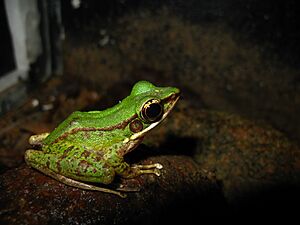Hose's frog facts for kids
Quick facts for kids Hose's frog |
|
|---|---|
 |
|
| Conservation status | |
| Scientific classification | |
| Synonyms | |
|
Huia hosii (Boulenger, 1891) |
The Hose's frog (Odorrana hosii) is a type of true frog. It lives in many parts of Southeast Asia. This frog was named after a zoologist named Charles Hose. Sometimes, its scientific name is misspelled as O. hosei.
Hose's frog has some close relatives. These include O. chloronota, which lives north of its home. Other relatives are O. livida and O. morafkai, found in Myanmar and Vietnam. Another close relative is O. megatympanum, which is only found in Vietnam.
Meet the Hose's Frog: Appearance and Sounds
This frog has a strong body and long, thin legs. Male frogs are about 50–60 millimeters (2–2.4 inches) long. Female frogs are larger, measuring 85–100 millimeters (3.3–3.9 inches).
The frog's back is usually dark green, and its sides are brown. Its belly is a pale color. Its legs have dark stripes across them. The tips of its fingers and toes have special sticky pads.
Hose's frogs can have different colors on their backs. Some are completely green, while others are all brown. You might also see them with green backs and brown spots, or brown backs with green spots. Their call sounds like a "cit," similar to a rat. Interestingly, their baby frogs, called tadpoles, do not have sticky mouths.
Where Hose's Frogs Live and How They Survive
Hose's frog can be found in many places. These include the Malay Peninsula, Phuket, Tioman, Borneo, the Batu Islands, Sumatra, Simeulue, Bangka Island, Belitung, and Java.
These frogs live in and around clear, fast-moving streams and rivers. They prefer rainforests up to 1,700 meters (about 5,500 feet) above sea level.
Even though their numbers are going down because of deforestation (forests being cut down), they are still common. Scientists have found that these frogs can handle some pollution. They can also live in forests that have grown back after being cut down. Because of this, the IUCN (International Union for Conservation of Nature) lists them as a species of Least Concern. This means they are not currently in danger of disappearing.
Life Cycle: How Hose's Frogs Reproduce
Hose's frogs likely lay their eggs in water, similar to other true frogs. However, their eggs are special. Inside their jelly-like outer layer, the eggs are creamy white. They don't have a dark spot on one side. This suggests that they lay their eggs in a very specific type of place.
Gallery



